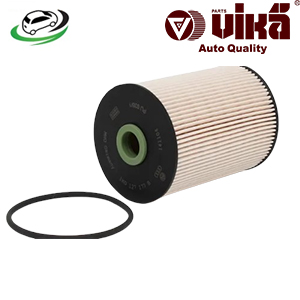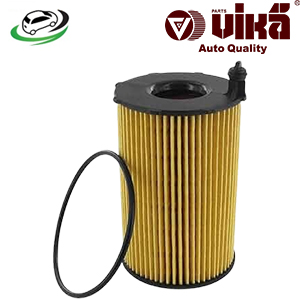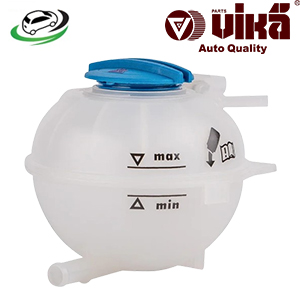-8%
Get Expansion Tank Coolant Assy VW Touareg (7L)/Passat/Polo 6R/9N / Audi A4/A1 8X1/8XA 6Q0121407A
The expansion tank, also known as the coolant reservoir, plays a vital role in a vehicle’s cooling system. It serves as a storage container for the coolant, managing the expansion and contraction of the coolant as the engine heats up and cools down. Here’s a detailed exploration of the expansion tank coolant, its function, benefits, maintenance, and common issues.
Purpose of the Expansion Tank
Coolant Storage
The primary purpose of the expansion tank is to store excess coolant that expands when the engine heats up. As the engine operates, the coolant expands and increases in volume. The expansion tank provides a place for this extra coolant to go, preventing overpressure in the cooling system.
Pressure Management
The expansion tank helps manage the pressure within the cooling system. It is typically equipped with a pressure cap that regulates the pressure to prevent the system from becoming over-pressurized. This cap also helps maintain the correct boiling point of the coolant.
Temperature Regulation
By providing a reserve of coolant, the expansion tank helps regulate the engine temperature. When the engine cools down, the coolant contracts and is drawn back into the cooling system from the tank. This process ensures that the engine remains at an optimal operating temperature.
Components of the Expansion Tank
- Tank Body: The main container that holds the coolant. It is usually made of plastic or metal and is designed to withstand the pressure and temperature changes within the cooling system.
- Pressure Cap: A cap that seals the expansion tank and regulates the pressure within the cooling system. It usually includes a spring-loaded valve that opens to release excess pressure and closes to maintain the correct pressure.
- Overflow Tube: A tube or hose that allows excess coolant to flow into the tank when the system is under pressure. It also allows coolant to flow back into the system as it cools and contracts.
- Level Sensor: Some expansion tanks are equipped with a level sensor or float that monitors the coolant level and alerts the driver if the level is too low.
Benefits of Proper Expansion Tank Coolant Management
Optimal Engine Temperature
Maintaining the correct coolant level and pressure ensures that the engine operates at its optimal temperature. Proper temperature regulation is crucial for engine performance, efficiency, and longevity.
Prevention of Overheating
The expansion tank helps prevent engine overheating by providing a reserve of coolant and managing pressure. This reserve is particularly important during periods of high engine load or when driving in hot conditions.
Protection Against Corrosion
High-quality coolant helps protect the engine and cooling system components from corrosion. Coolant contains additives that prevent rust and corrosion within the engine and radiator.
Improved Engine Efficiency
A well-maintained expansion tank and coolant system contribute to better engine efficiency. Proper temperature regulation leads to more efficient combustion and improved fuel economy.
Reduced Emissions
Maintaining optimal engine temperature helps ensure complete combustion of fuel, which reduces harmful emissions. Proper coolant management contributes to a cleaner running engine.
Maintenance of Expansion Tank Coolant
Regular Inspections
- Coolant Level Check: Periodically check the coolant level in the expansion tank, especially before long trips or in extreme weather conditions. The level should be between the “Low” and “Full” marks on the tank.
- Visual Inspection: Inspect the expansion tank for cracks, leaks, or damage. Look for signs of coolant leaking around the tank or connections.
Coolant Replacement
- Follow Manufacturer’s Guidelines: Replace the coolant according to the manufacturer’s recommendations, which are typically outlined in the owner’s manual. The replacement interval may vary based on the vehicle and type of coolant.
- Coolant Type: Use the recommended type of coolant for your vehicle. Different types of coolant have varying chemical compositions and properties.
Pressure Cap Maintenance
- Inspect the Cap: Regularly check the pressure cap for signs of damage or wear. A faulty cap can lead to coolant leaks or pressure issues.
- Replace if Necessary: Replace the pressure cap if it is damaged or not functioning properly. A new cap ensures proper pressure regulation within the cooling system.
System Flushing
- Periodic Flushing: Flush the cooling system periodically to remove any contaminants, old coolant, or debris that may have accumulated. Flushing helps maintain the efficiency of the cooling system and prevents potential problems.
Addressing Leaks
- Fix Leaks Promptly: If you notice coolant leaks from the expansion tank or elsewhere in the cooling system, address them promptly. Leaks can lead to low coolant levels, overheating, and potential engine damage.
Common Issues with Expansion Tank Coolant
Low Coolant Level
- Symptoms: Low coolant levels can cause the engine to overheat, trigger warning lights, or result in poor performance.
- Causes: Low coolant levels may be due to leaks, evaporation, or improper maintenance.
Overheating
- Symptoms: Engine overheating can lead to steam from the engine bay, fluctuating temperature gauges, or warning lights.
- Causes: Overheating may result from insufficient coolant in the expansion tank, a faulty pressure cap, or a clogged radiator.
Leaks
- Symptoms: Coolant leaks can manifest as puddles under the vehicle, a noticeable coolant smell, or visible coolant around the expansion tank.
- Causes: Leaks can occur due to cracks in the expansion tank, damaged hoses, or faulty seals.
Pressure Cap Issues
- Symptoms: A faulty pressure cap can lead to overheating, coolant leaks, or fluctuating coolant levels.
- Causes: Issues with the pressure cap can arise from worn-out seals, damaged springs, or improper sealing.
Contaminated Coolant
- Symptoms: Contaminated coolant may appear rusty, muddy, or have a foul odor. It can also cause cooling system issues or reduced efficiency.
- Causes: Contamination can result from a lack of regular maintenance, leaks, or mixing incompatible types of coolant.
Follow us on Facebook for more parts.



